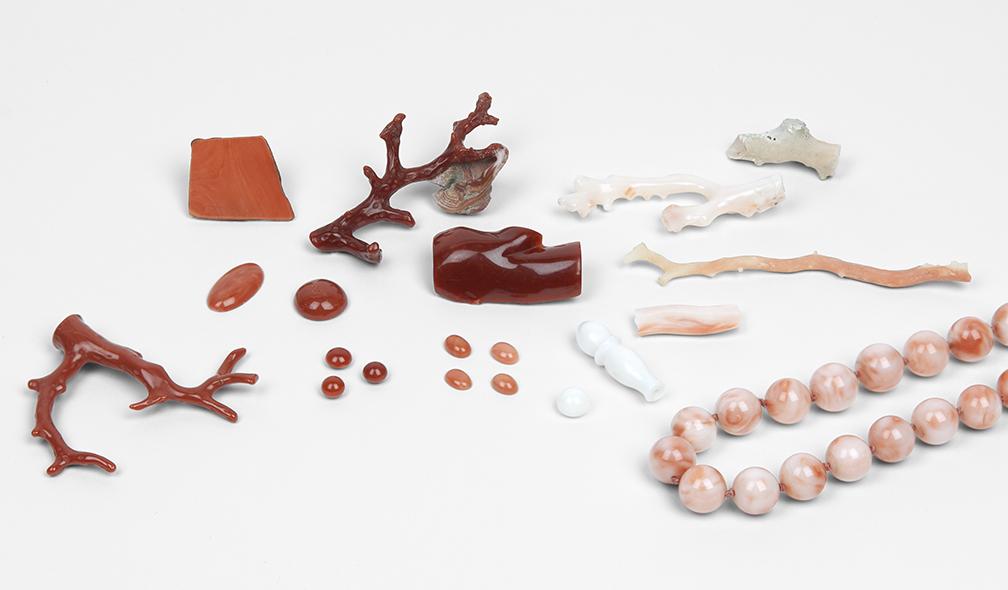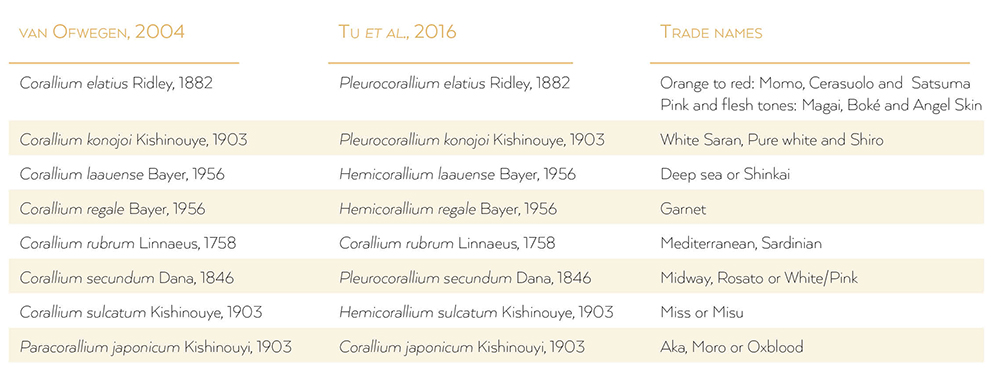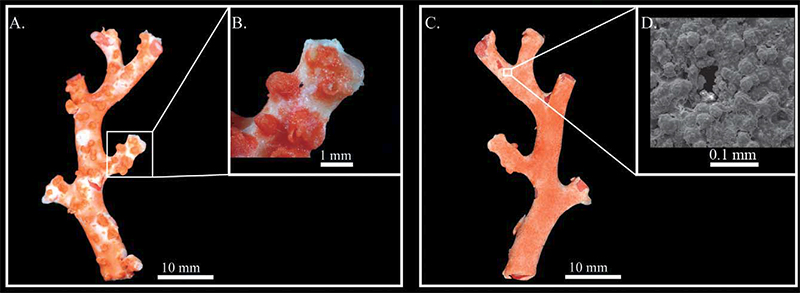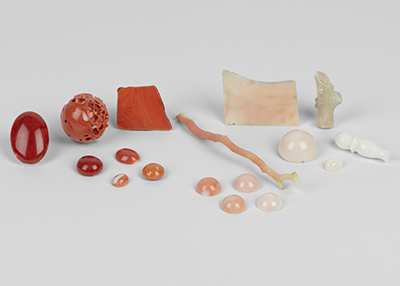
Review and update of the classification of precious corals
Introduction
"Precious coral" is a general term that describes the species of natural coral (with mineral endoskeleton) used in the jewellery industry. They are highly valued and sought-after for their physical properties (toughness, lustre, workability) and their bright colours ranging from deep red to orange and variations from pink, pink-orange to white. Although they share the same name "precious coral", they all have their own taxon in the classification system for living organisms.
Note that a taxon is a group of living beings with common characteristics (because of their kinship), considered by taxonomists as forming a unit. This makes it possible to classify individuals.
In biology, "precious corals" belong to the phylum Cnidaria (Hatschek, 1888), the subclass Octocoralliarids (Haeckel, 1866) and the family Coralliidae (Lamouroux, 1812).
In this family, which has 43 valid species in 3 genera (Tu et al., 2015), 8 species are known to be harvested for their use in jewellery and are therefore called "precious coral".
Discussion
As far as their classification is concerned, numerous updates and suggestions have been recorded and approved over the years. The traditional classification that is still the most used by professionals and the general public is the one introduced by van Ofwegen in 2004.
It indicates that the family Coralliidae is divided into two genera: Corallium (Bourne, 1900) and Paracorallium (Bayer and Cairns, 2003).
However, in the light of recent studies on mitochondrial, mitogenomic, and nuclear markers as well as morphological characteristics (Ardila et al., 2012; Figueroa and Baco 2014; Tu et al., 2015; Tu et al., 2016; Uda et al., 2013), the genus Paracorallium is no longer considered a valid taxon as all its species are nested into the genus Corallium, with Paracorallium thus subsumed within Corallium (Ardila et al., 2012). Note that in scholastic philosophy, to report, to refer an individual to a species; to report, to refer a species to a genus.
The new classification (Tu et al., 2016) of Coralliidae divides the family into three genera: Corallium, Hemicorallium, and restores Pleurocorallium (Gray, 1867), see (Ardila et al., 2012; Figueroa and Baco 2014; Tu et al., 2015; Tu et al., 2016).
The accepted status of species used in jewellery according to the new classification is as follows:

It is worthy to note that part of the P. elatius fished in the Taiwan Province of China for the jewellery trade may contain a recently discovered species P. carusrubrum (Tu et al., 2012) (figure 1) as it has been reported to be circulating as pink coral (Jeng, 2015) .

Fig. 1: Holotype of: Corallium carusrubrum n. sp., ASIZ0000960: (A) "front" of the colony; (B) close-up of the cortical mounds; (C) "back" of the colony; (D) EM image of the cortex - the pore is the opening of a solenian canal. After Tu et al., 2012.
Following this discovery, a new genetic study (Tu et al., 2015) indicates that the boundaries between three species of Asian waters (P. carusrubrum, P. elatius and P. konojoi) are ambiguous and should be grouped and referred to as the "Pleurocorallium elatius complex" (Tu et al., 2015) (Figure 2).

Fig. 2 - Hue variations of the corals of the P. elatius complex. Coll. SGDF, Photo M. Rondeau.
Conclusion
To not confuse the trade or customs and abiding by the new classification (Tu, et al., 2012), GGTL Laboratories Switzerland will issue coral reports mentioning the traditional classification of Van Ofwegen’s as well as the coral “type” of the “P. elatius species-complex” of Tu, Dai and Jeng.

Bibliography
- Ardila, N. E., Giribet, G., & Sanchez, J. A. (2012). A time-calibrated molecular phylogeny of the precious corals: reconciling discrepancies in the taxonomic classification and insights into their evolutionary history. BMC Evolutionary Biology, 12(1), 246.
- Figueroa, D. F., & Baco, A. R. (2014). Complete mitochondrial genomes elucidate phylogenetic relationships of the deep-sea octocoral families Coralliidae and Paragorgiidae. Deep Sea Research Part II: Topical Studies in Oceanography, 99, 83-91.
- Jeng, M-S. (2014). The sustainable use of precious corals. Final report on International Symposium on Pacific Precious Corals 2014. Taipei, Taiwan POC.
- Tu, T. H., Dai, C. F., & Jeng, M. S. (2012). Precious corals (Octocorallia: Coralliidae) from the northern West Pacific region with descriptions of two new species. Zootaxa, 3395(1), 1-17.
- Tu, T. H., Dai, C. F., & Jeng, M. S. (2015). Phylogeny and systematics of deep-sea precious corals (Anthozoa: Octocorallia: Coralliidae). Molecular phylogenetics and evolution, 84, 173-184.
- Tu, T. H., Dai, C. F., & Jeng, M. S. (2016). Taxonomic revision of Coralliidae with descriptions of new species from New Caledonia and the Hawaiian Archipelago. Marine Biology Research, 12(10), 1003-1038.
- Uda, K., Komeda, Y., Fujita, T., Iwasaki, N., Bavestrello, G., Giovine, M., ... & Suzuki, T. (2013). Complete mitochondrial genomes of the Japanese pink coral (Corallium elatius) and the Mediterranean red coral (Corallium rubrum): a reevaluation of the phylogeny of the family Coralliidae based on molecular data. Comparative Biochemistry and Physiology Part D: Genomics and Proteomics, 8(3), 209-219.
Taxonomic references
Authors:
- Maurane Rondeau, GGTL Laboratories Switzerland. LinkedIn.
- Franck Notari, GGTL Laboratories Switzerland. ResearchGate, LinkedIn.
© GGTL Laboratories Research Note.
